Shona Vertue moves a lot. The personal trainer, yoga teacher, former gymnast and now psychology student swims, surfs, practises yoga and does Brazilian jiu-jitsu – she is rarely still for more than 25 minutes at a time. “My body hates me if I don’t move,” the Australian tells me, on the phone from Sydney. “Our bodies need movement to survive.”
Covid has led to many of us to spend more time online, while working from home and becoming housebound. It has meant a year of reduced movement – and that has been especially damaging for our bodies.
“A sedentary lifestyle can be problematic for all aspects of living in a human body, from immunity to cognitive performance. But when exercise involves a gym mat 2 metres from your desk, it isn’t very motivating,” says Vertue, who started teaching yoga in 2008, becoming a personal trainer two years later (clients include David Beckham, whom she worked with for three years). Vertue’s method combines weighted resistance training and cardio with her lifelong passions of yoga and mediation, and places as much importance on rest and recovery as fitness.
Our necks and backs have borne the brunt of our inaction. According to a UK survey of people working at home carried out last April by the Institute for Employment Studies, more than half of respondents reported new neck, shoulder and back problems. Contrary to popular belief, stiffness and aching shoulders are not caused so much by how we sit, but by spending too long in one position, Vertue says. “Think of your head as a bowling ball pulling on your spine, with little movement – it’s no wonder we ache; our bodies weren’t designed to be like this.”
Regular movement helps the whole body. “It improves circulation, directs lymphatic fluid throughout the body, lubricates joints, and builds strength and stability,” she says. “Ensuring that you get all your joints moving at regular intervals during the day is more helpful than we realise.”
When Vertue is at home, and particularly when she’s studying, she sets a timer that forces her out of her chair every 25 minutes, for five minutes. She either goes for a brisk walk or performs a few stretches on her mat. “After four five-minute breaks, I take a bigger break of 25 minutes. One of the best things you can do [to combat stiffness] is to stand up. It’s really underrated. It fully extends your hips. Otherwise, our glutes atrophy, which can lead to back and knee problems. And then all kinds of things can go wrong.”
As well as regular movement, exercises that strengthen the muscles in our necks and backs can help repair the damage caused by home workstations, closed gyms (and, in Vertue’s case, beaches), and too much sofa-sitting. She has designed a series of moves to target muscles that often get overlooked, and to prevent further damage. “They are really small movements. Often what our necks and backs need is strengthening,” Vertue says. “It can feel good to stretch something that is sore, but, in the same way that taking a painkiller doesn’t fix the underlying problem, stretching a stiff neck or back isn’t going to fix the cause of that stiffness.” More serious problems may need the help of a specialist.
It’s likely that our whole body requires attention post-lockdown. The gluteus maximus (the main muscle in our backsides and the biggest in our body) can atrophy when the body is too sedentary. “The body will only hold on to muscle that is being used, so if we’re not using our glutes or retractor muscles in the shoulders, we will essentially lose them. And when we lose these muscles, our musculoskeletal system can’t function the way it should, and we begin to develop weaknesses that can lead to imbalances and pain.”
Little and often is key to making lasting changes, Vertue says. “It’s easy to feel overwhelmed by the volume of fitness programmes online. Signing up to a 12-week programme will make it feel like a project, when, really, doing key, simple exercises should be like cleaning our teeth.”
She is fascinated by our attitude to keeping fit, and is taking a BA in psychology in order to better understand her clients’ motivation – or lack of it. “Choosing to take action, to keep fit, is a health behaviour, but it’s governed by our overall behaviour. The mind is powerful, particularly when it comes to resistance, and I want to understand that better,” she says.
We need to reframe how we see exercise, Vertue adds. “The narrative around it has become too much about the aesthetics. Rather than say to yourself, ‘I want to look like this or that’, think of more beneficial goals: ‘I’d like to do my job without back pain’, or ‘I want my hips to function for a long time.’” Use your muscles, Vertue says again, or lose them. So what are you waiting for?
Five simple moves to ease back and neck pain
1 Cat-cow
a) Come into an all-fours position, with your hands shoulder-distance apart, your knees hip‑distance apart.
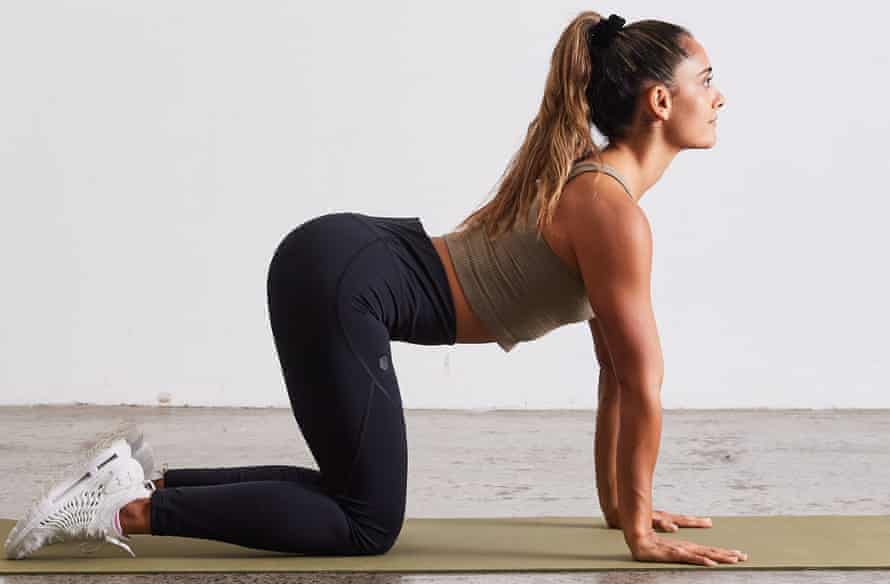
b) Take a breath in and begin to drop your belly down, lifting up through your head and hips.
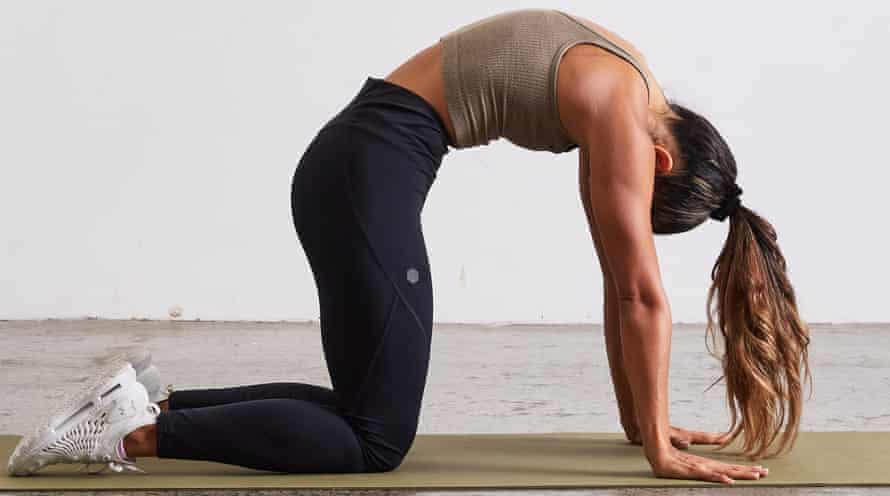
c) Press into the hands, draw your belly button and lower ribs towards your spine as you round your back and drop your head forward. Repeat this, with constant focus on the breath, 10 times.
2 Neck lateral flexion

a) Lie on your left side, with your left arm out in front of you, and your right arm supporting. Allow your head to relax down to the floor. Take a breath in.

b) Exhale, lift your head up, bring your right ear to your right shoulder. Hold for one second. Slow release. Repeat 10 times each side.
3 Protraction push-ups
a) Come into a push-up position with your legs extended and knees off the floor. Squeeze your glutes and tuck in your tailbone.

b) Push the floor away and feel as though you’re spreading your shoulder blades off your upper back.

c) Once you’ve reached maximum capacity, begin to slowly drop your chest towards the floor, so your shoulder blades come back towards the spine. Repeat 10 times.
4 Neck retraction
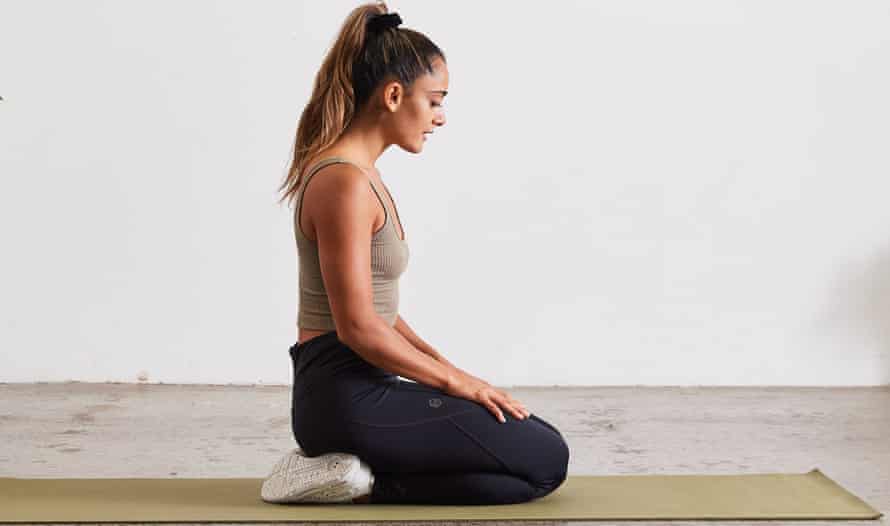
a) Come into a seated position with a relaxed spine, head slightly titled forward (as though you’re looking at your phone).
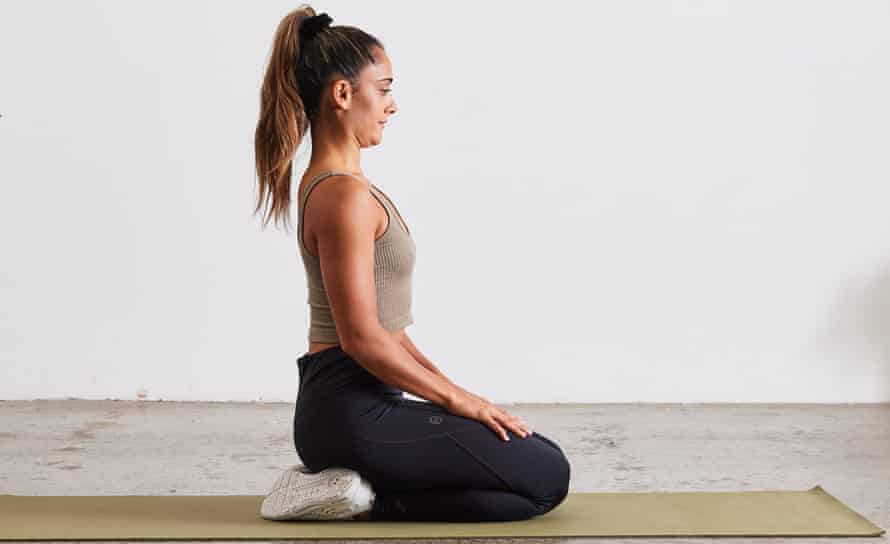
b) Retract your chin back towards your throat and imagine someone pulling you upwards from the crown of the head. Repeat 5-10 times.
5 T-rotations
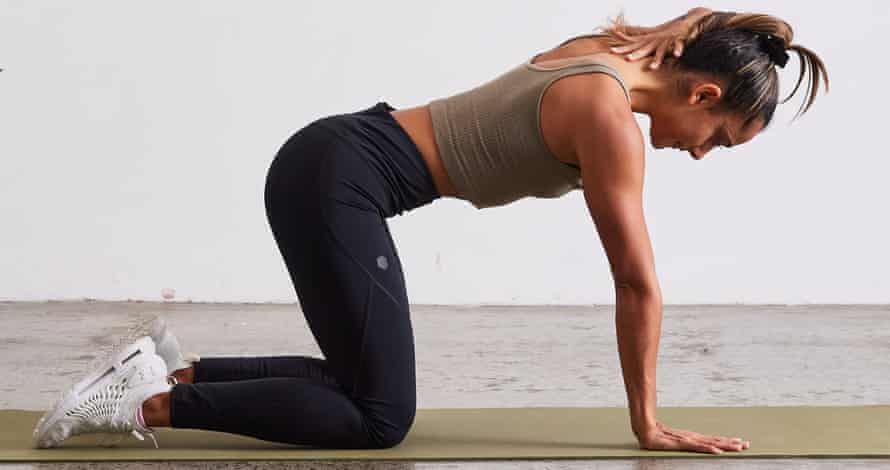
a) Come into an all-fours position. Place your left hand on the back of your neck.

b) As you exhale, turn your torso and left elbow towards the ceiling. Ensure that your pelvis does not move as your twist.

c) Inhale and bring the elbow towards the floor. Repeat 10 times each side.
from Lifestyle | The Guardian https://ift.tt/3vVXyhI
via IFTTT

comment 0 Comment
more_vert